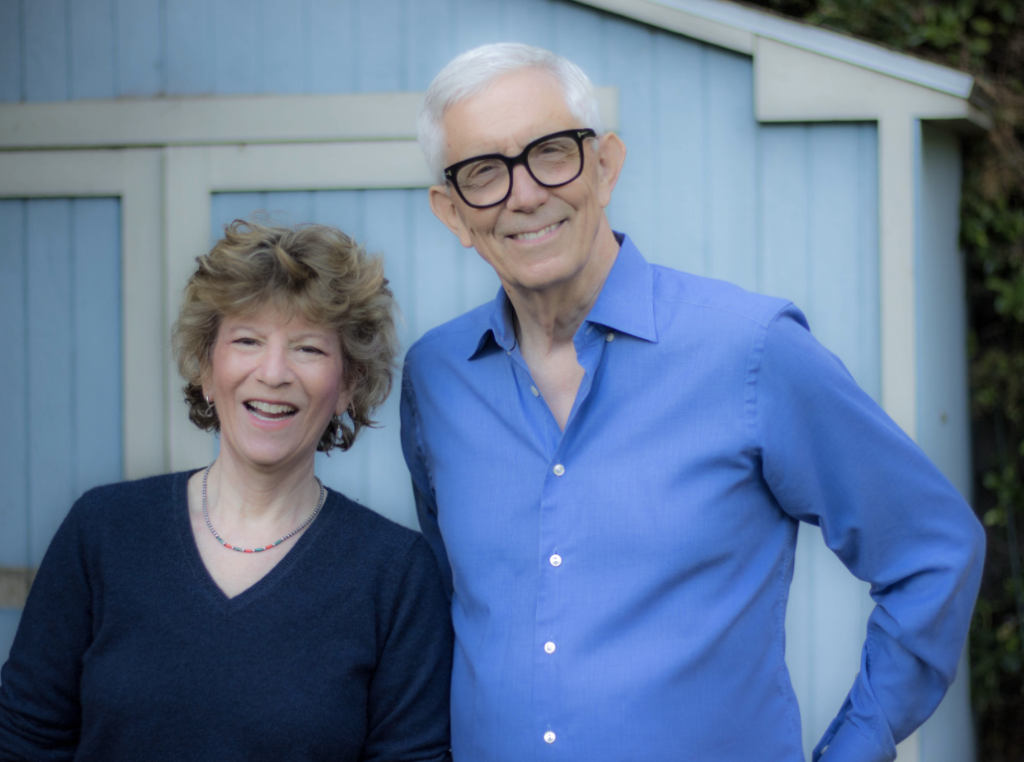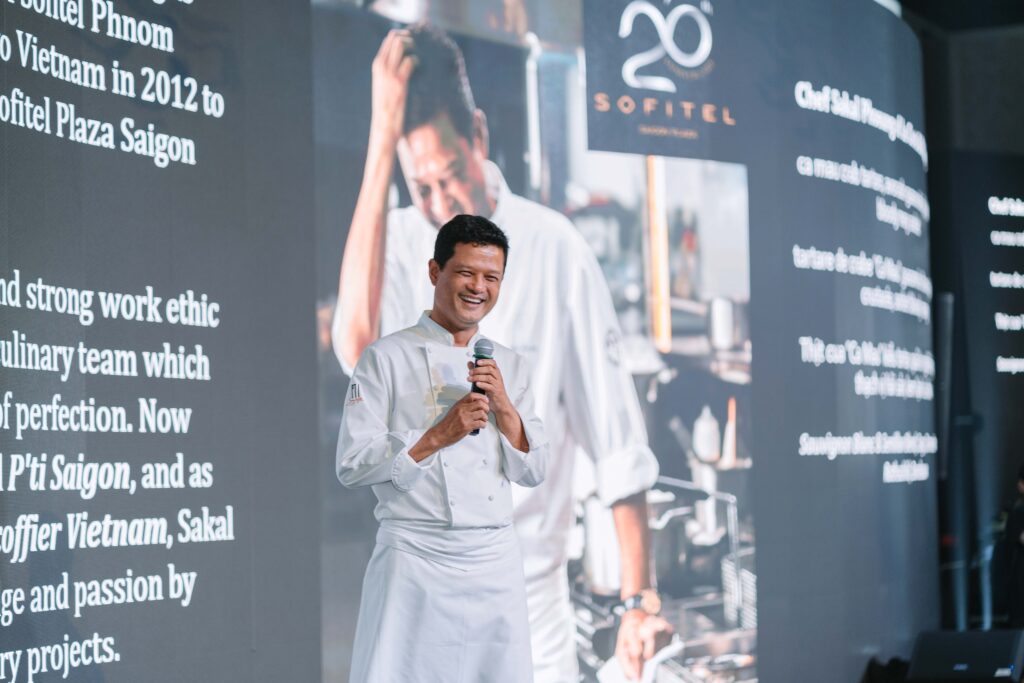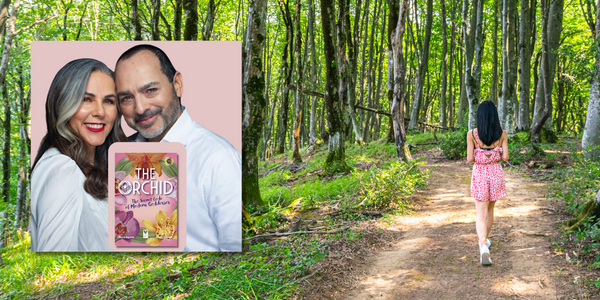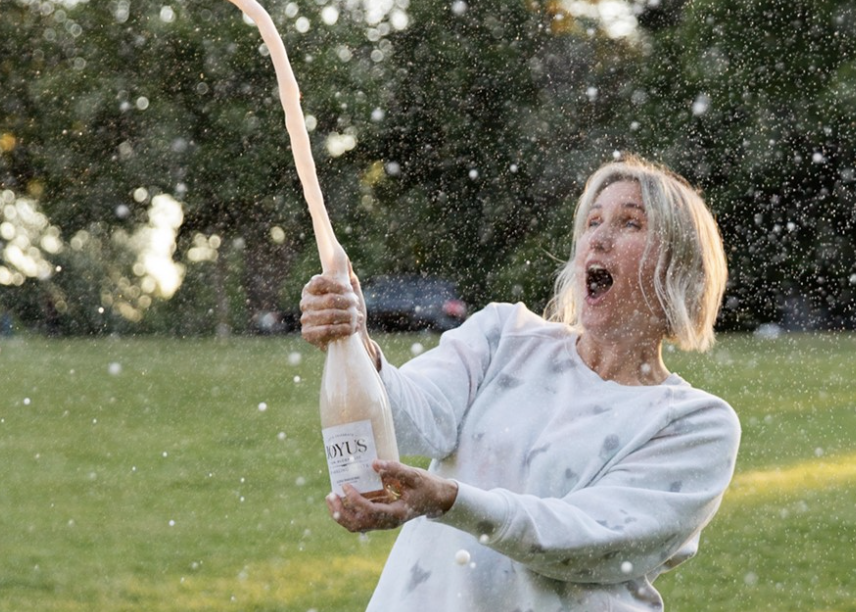Fiery yet Refreshing! Flavor! Fire! Expand Your Hot Sauces Collection with Truff Jalapeño Lime Hot Sauce
Truff expands hot sauce with Truff Jalapeño Lime Hot Sauce
TRUFF, the truffle brand known for reimagining and elevating pantry staples, releases TRUFF Jalapeño Lime Hot Sauce, its newest hot sauce variation.

Truff Expands their Hot Sauces with Jalapeño Lime Hot Sauce
This vibrant green sauce boasts an entirely new flavor profile – and color – from the brand’s line of luxurious hot sauces.
It offers a harmonious blend of fiery green jalapeño peppers and refreshing lime with TRUFF’s namesake ingredient, the black winter truffle.
“Our goal with TRUFF has always been to create products
so unique that they offer a flavor experience like no other,”
Nick Ajluni
Co-Founder and Co-CEO at TRUFF
“This time, we are taking inspiration from the rich, vibrant, and colorful culture of Latin cuisine to create a flavor profile that has yet to be explored.”

Truff’s Jalapeño Lime Hot Sauce
TRUFF has brought truffle-infused products to a broad consumer base through its premium condiments line spanning hot sauce, pasta sauce, mayonnaise, oil and salt. TRUFF’s hero product, its hot sauce, is a leading seller in the natural channel and the fastest-growing hot sauce in conventional grocery.
The new TRUFF Jalapeño Lime Hot Sauce is the brand’s latest addition
“We dove deep into Latin cuisine, indulging in endless tacos, ceviches, aguachiles and chilaquiles. We noticed that two ingredients – green jalapeño and lime – were commonly used to complement and enhance dishes,” says Nick Guillen, Co-Founder and Co-CEO at TRUFF.

Truff’s Jalapeño Lime Hot Sauce
“We pursued these bold flavors and the result is a sauce that is both elevated and celebratory in nature. Whether drizzled over dishes from your local taco truck or added to a Michelin-starred culinary creation, the TRUFF Jalapeño Lime Hot Sauce is designed to elevate any meal.”
TRUFF Jalapeño Lime Hot Sauce will be available in 6-ounce bottles
TRUFF’s new Jalapeño Lime Hot Sauce will be available in 6-ounce bottles topped with TRUFF’s distinctive truffle-inspired cap in a captivating green. It will launch exclusively at Whole Foods Market this January and will be available online at TRUFF.com starting January 11, 2024.
TRUFF has experienced groundbreaking company growth since its launch in 2017. The brand’s distinctive flavor, high-quality ingredients, new product innovation, and social following have helped it build a significant base of loyal consumers, an impressive list of collaborators, and accolades.
The brand’s latest partnerships include launches with Popeyes Louisiana Kitchen and The Super Mario Brothers Movie. In November of 2023, it was announced that SKYY Partners— Jay Sammons and Kim Kardashian’s private equity firm focused on high-growth, market-leading consumer brands — had acquired a significant minority stake in TRUFF.

For more information please visit TRUFF.com or @sauce on Instagram.
TRUFF’s lineup of luxury pantry staples is designed to elevate the dining experience.
TRUFF’s lineup of luxury pantry staples is designed to elevate the dining experience. Originally founded through a popular food and lifestyle Instagram blog called @sauce, TRUFF immediately propelled into social media virality with the release of its hot sauce in 2017.
The brand quickly became the fastest growing company in the hot sauce space due to its distinctive flavor profile, pristine bottle, Truffle Inspired cap, and of course the coveted Instagram account @sauce that makes tagging a no-brainer. Taking inspiration from the flagship black truffle experience, TRUFF has expanded its family of products to include other popular favorites like Pasta Sauce, Mayonnaise, Oil and Salt.
You can find TRUFF’s variety of products in stores nationwide and around the world in the UK, Australia, Kuwait, and South Korea. TRUFF is gluten-free and non-GMO. Visit www.TRUFF.com for more information and recipes.
YOU MIGHT ALSO LIKE
Bubbly East Coast Prosecco Tasting! Discover with Wine Expert Alan Tardi Wed June 26th at New York Wine Studio
DC Heads to NYC for Prosecco! Taste and Discover with Wine Expert Alan Tardi Wed June 26th at New York Wine Studio
Prosecco has gone from a little known mountain fizz to a vinous superhero, overtaking Champagne (and every other sparkling wine out there) and enjoyed by wine drinkers throughout the world, as the base of a cocktail or an everyday quaff.
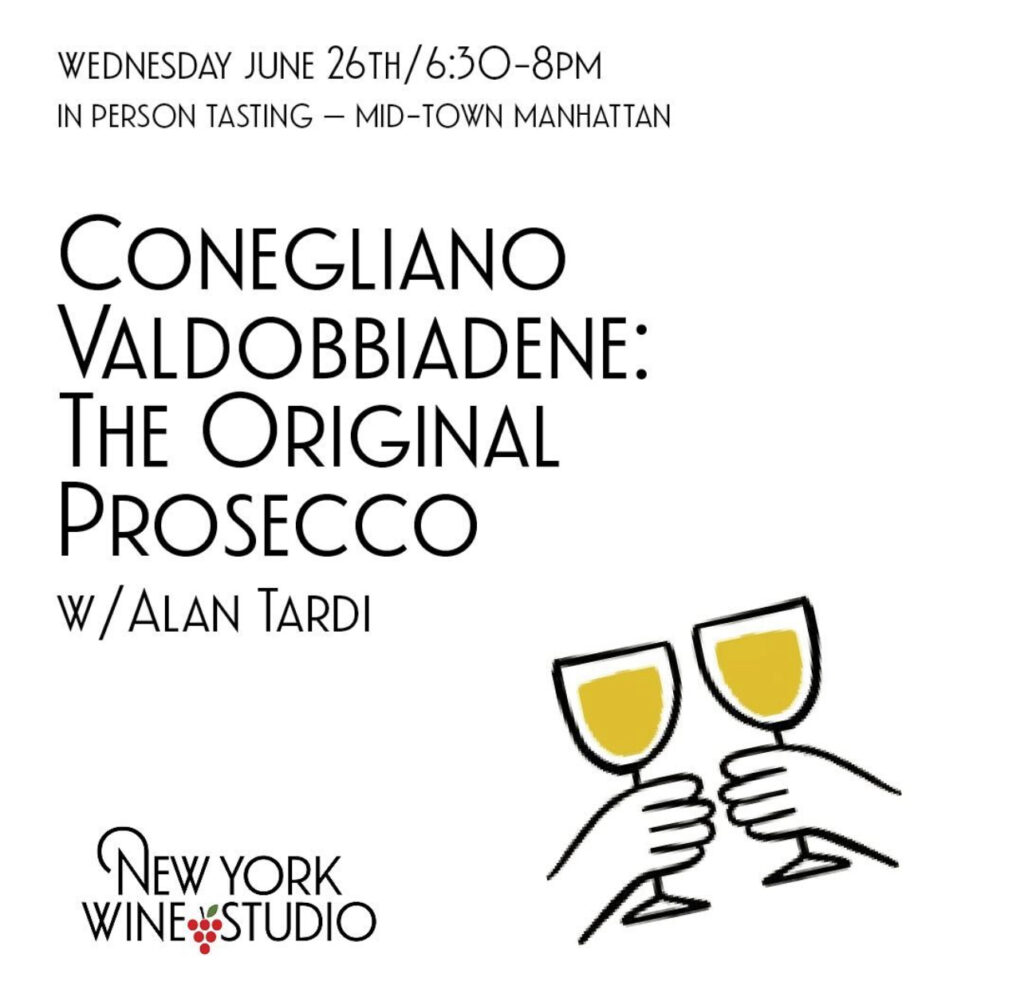
But despite its huge popularity, most people don’t know much about it.
And there is much more to Prosecco than many people are aware.
”My objective is to
clarify the critical differences
between the original ancient Conegliano Valdobbiadene Prosecco and
the DOC Prosecco that was enacted in 2010.”
Alan Tardi
New York Wine Studio
Prosecco is produced only in Italy, in the Northern regions of Veneto and Friuli, and there are three official Prosecco appellations.

Prosecco DOC
One of them, Prosecco DOC, was created in 2010. It occupies a huge, mostly flat area encompassing almost two entire regions and accounts for most of the 700+ million bottles of Prosecco produced each year.
Conegliano Valdobbiadene Prosecco DOCG
Conegliano Valdobbiadene Prosecco DOCG is a tiny area in the foothills of the Dolomites consisting of 15 small municipalities in the province of Treviso. This is the ancient winegrowing area where Prosecco was born and made a miraculous comeback in the aftermath of World War II.

New York Wine Studio’s Alan Tardi
Besides its pedigree, there are numerous factors of the Conegliano Valdobbiadene enclave that distinguish it from any other winegrowing area in the world: complex and diverse topography, variety of soils, native grape varieties, distinct sub-areas, ancient history, and varied typology—bubbly, fizzy, and still; secondary fermentation in tank or in bottle, leaving sediment in the bottle (known as Ancestral Method) or removing it (Traditional Method).

In this class—which takes place right in the middle of National Prosecco DOC week—we will discuss the origin and evolution of Prosecco in the Conegliano Valdobbiadene area. We will also examine the two additional Prosecco appellations created in 2010.
But most of the time will be devoted to exploring and tasting Conegliano Valdobbiadene Prosecco through a lineup of 8 exceptional terroir-driven wines, in a variety of styles, that demonstrate the unique characteristics, complexity, and diversity of the original Prosecco.
Participants will also learn how to say “CONEGLIANO VALDOBBIADENE” like an Italian!

Alan Tardi has arranged a fantastic lineup of unusual and exceptional wines (half of them are coming directly from Italy) which demonstrate the various factors that characterize the complexity and uniqueness of Conegliano Valdobbiadene: Different production methods (“Tranquillo” i.e. still, Martinotti, Classico/Traditional, Ancestral); frizzante, spumante; single vineyards, Rive, native grape varieties; diverse, soils, terroirs and topographies.
List of Wines
- Prosecco Tranquillo DOCG “Il Canto Antico” — BORTOLOMIOL*
- Colli Trevigiani IGT Verdiso Frizzante Sui Lieviti — GREGOLETTO
- Progetto 5 Varietà Conegliano Valdobbiadene DOCG Brut — MARCHIORI*
- Conegliano Prosecco Superiore DOCG Rive di Ogliano Extra-Brut — BIANCAVIGNA
- Superiore di Cartizze Brut DOCG — RUGGERI*
- Superiore di Cartizze DOCG “Private” Rifermentato in Bottiglia 2014 — BISOL
- Conegliano Valdobbiadene Prosecco Superiore DOCG Rive di Carpesica “S.C. 1931” Metodo Classico — BELLENDA*
- Valdobbiadene Prosecco Superiore DOCG Asciutto, Rive di Colbertarldo, Vigneto Giardino — ADAMI
- Torchiato di Fregona Colli di Conegliano DOCG “Ciàcoe” 2016 — CA’ DI RAJO*
*Shipped directly from the winery in Italy
Find more information and buy tickets at New York Wine Studio or at the link below.
https://www.newyorkwinestudio.com/original-prosecco
Bob Dylan’s Bourbon Feud: Heaven’s Door Kentucky vs Tennessee
Bob Dylan’s Bourbon Feud: Heaven’s Door Kentucky vs Tennessee
Heaven’s Door Spirits, Bob Dylan’s highly awarded collection of super-premium American whiskeys, is turning up the heat on the age-old debate of which state, Tennessee or Kentucky, makes the best bourbon.
For as long as corn’s been cracked and stills have bubbled, Kentucky and Tennessee have been turning pristine limestone water and grains into a coveted amber elixir.
Heaven’s Door’s Great State Bourbon Debate rekindles the friendly feud
Heaven’s Door’s Great State Bourbon Debate rekindles the friendly feud between these two bourbon powerhouses, inviting whiskey lovers everywhere to put their palates to the test and voice their opinion.
Heaven’s Door sets itself apart as the first brand to offer both a Kentucky and Tennessee bourbon, giving fans a unique chance to compare.
The brand’s Kentucky Straight Bourbon, Ascension, and Tennessee Straight Bourbon, Revival, are made from high rye mash bills with grains largely sourced local to the distillery, and barreled at the same proof, yet yield vastly different taste profiles. Heaven’s Door invites you to level set, savor and decide which bourbon pleases your palate and wins your heart.
A Tale of Two Bourbons
Many folks mistakenly believe that bourbon can only be made in Kentucky, but the truth is, bourbon can be crafted anywhere in the U.S.
What makes an American whiskey a true bourbon is a special set of rules: it has to be made with at least 51% corn, distilled at a certain proof, and aged in new oak barrels.
Kentucky and Tennessee both have storied histories of producing excellent bourbon, with differences in water and climate producing distinct flavors.
Kentucky’s limestone water and Tennessee’s pure spring water are both famous for helping yeast thrive during fermentation.v
Differences in flavor profile come from the type and provenance of the grains used, the type of yeast used, water quality, the proof at distillation and the particular wood used to make oak barrel.
Even the location of the barrel warehouse, the circulation of air between the barrels being stored and where the barrels are within the warehouse (high up or near the bottom) all conspire to give impart flavor differences.
Heaven’s Door Kentucky Straight Bourbon, Ascension
Heaven’s Door Kentucky Straight Bourbon, Ascension, is a unique blend of two premium Kentucky straight bourbons aged for over five years and non-chill filtered, boasts warm and slightly sweeter notes of vanilla and baking spices. The limestone-filtered water of Kentucky, renowned for its purity, plays a key role in developing these rich flavors.
Heaven’s Door Tennessee Straight Bourbon, Revival
Heaven’s Door Tennessee Straight Bourbon, Revival, also aged for over five years and non-chill filtered, offers a drier profile with complex and sharp flavors. Unlike many Tennessee bourbons, Revival skips the “Lincoln County Process” – a charcoal filtering step – allowing the natural flavors of the local non-GMO grains to shine through, resulting in a lingering finish with hints of caramel, cinnamon, and nutmeg.
“We wanted to fan the flames of this old debate
between Kentucky and Tennessee bourbon
and showcase
our outstanding expressions of both styles.
We’re excited to hear what consumers think and how they experience these two classic bourbons.”
Alex Moore
Master Blender and COO
Heaven’s Door Spirit
Heaven’s Door marries art and craft in every bottle, drawing inspiration from Bob Dylan’s restless spirit to continually innovate. By sourcing non-GMO grains and honoring each state’s natural elements, the distinct character of each bourbon is evident in every sip.
Yo DC! Following your Heart and Need Media Attention? Reach to Publicity For Good, CEO Heather Holmes explains
Yo DC! Following your Heart and Need Media Attention? Reach to Publicity For Good, CEO Heather Holmes explains
Publicity for Good is a millennial run communications firm that provides high-level disruptive, publicity and social media services for wide array of purpose driven clients in the food, beverage and beauty industry.
In 2016 by Heather Holmes former miss Ohio international celebrated publicist and Forbes 30 under 30 nominee publicity for good has built a reputation as the countries number one PR agency for CPG brands that have social causes built into their DNA.
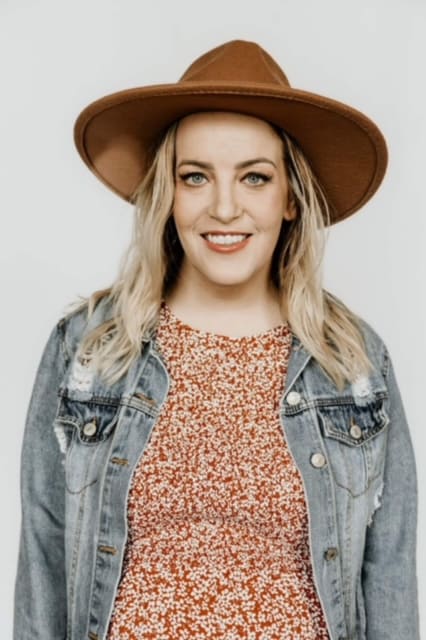
Publicity For Food CEO Heather Holmes
Today’s conversation with Heather Homes from PublicityForGood.com has been edited for length and clarity. For the full, un-edited conversation, visit our YouTube channel here.
Joe Winger:
Heather Holmes from PublicityForGood.com. I’m a big fan because you’ve helped us facilitate a lot of previous conversations about food and drink and nutrition and all the things we like talking about.
What’s the most important thing that you want to share with the audience today?
Heather Holmes:
I really want to take away the unknown or worry about getting in the media. I want to make it more accessible to amazing brands and people.
So I definitely want to share tactical advice that if someone is reading this, they have a good story in business, they have the confidence that their story is good enough and they could absolutely make an impact and grow their business by getting in the media.
Joe Winger:
Starting with the basics, let’s pretend I have a company, I think I want public attention. I want to reach out to someone like you.
So what should I be thinking about? What do I present to you as a step one?
Heather Holmes:
Step one is really the intentionality of why you want to get in the media. What’s your goal? Are you wanting to reach more people? Are you wanting to get your story out there?
Are you wanting more sales and more people to buy your product?
You really need to know. Where you’re going first, and if you don’t know where you’re going, or you don’t have a vision, then it’s really hard to help you.
But if you have clarity there, then we can really pull back and help you identify your story, how you’re different, your why, and why your product and or company, would be really great to be in the media.

The PublicityForGood Team
Joe Winger:
Now, looking at the grand scheme of the campaign, what kind of a campaign should we be looking for: expectations, results?
Heather Holmes:
After we know our outcome that we’re wanting to get more sales, more backlinks, or name in the media, then what I like to do first is work with every entrepreneur, and even if you have a product, to really reflect in “why your story matters”
Why does your product matter?
If you’ve never been in the media before, I take people for an exercise where I have them draw on a piece of paper, them as a baby, to where they are now.
I have them write the key pivotal moments that have happened in their life that have made them start that company, because those little components are absolutely a part of your story.
I’ve been in the media 700 plus times: Inside Edition, Fox News, The New York Coast, incredible media, but it hasn’t always been about being a publicist, right?
Yes. I’m the founder of Publicity For Good, but a lot of that has been my story or building a seven figure company from an airstream.
Now I have almost two under two with a third on the way.
So you need to have your key pivotal moments because those are things you can talk about in the media.
Then we need to look at what’s going on in the news and how we bridge the gap between your product. Relevancy.

Joe Winger:
People may not know you are a former Miss Ohio International. Can you tell us a lesson you learned from being a former Miss Ohio International that you’re using in today’s work?
Heather Holmes:
It’s really all about your platform and reaching new audiences.
When I was building my company I decided I wanted to get into pageants. I wanted to meet a community of like minded people that wanted to make a difference in the world.
It was a way for me to have a platform because at the time I was talking about why you absolutely can build a profitable business. But also make a difference in your community and make a difference amongst your team. And really just build an incredible legacy.
So that was why I did the pageants.
I did a bunch of publicity and again, it made me relevant and timely because that was what got me in the media because I was Miss Ohio and I was only Miss Ohio International for a period of time.
So it gave me that relevancy. So you have to be relevant.
You have to bridge the gap between what’s happening in the news, or we often use Awareness Days, National Nutrition Month, National Social Media Day, and you have to position your product or yourself as the solution.
[For example], we were talking about an incredible juice brand, but most pitches I see are very promotional, right? It needs to be how you or your product simplifies people’s lives. How are you adding value? Or you don’t have a product you need to inspire people.

Joe Winger:
You’re growing a 7- figure business. What’s it like growing a huge business while you’re taking care of your kids and for a while you were living out of your Airstream
Heather Holmes:
We lived out of a 23 foot airstream for 3 1/2 years. I went from dating to engaged, to married to [my first child] Rose, who’s almost two, who lived in our airstream with us.
The year the pandemic [hit] was our first million dollar year.
I think a lot of the reason why it was that year is because when March hit, everyone was so scared that we lost about 40% of our business, number one.
Number two, we had to hustle and grit to make it. There was no choice of failing. All the distractions were gone.
When you’re in an Airstream, all you have is your laptop, but we had no external distractions, and then everything else was closed.
So the only focus we could do was our business and we had to scale out of necessity because we didn’t want to lose what we had put so much time in.
Fast forward, we now have 22 acres where we live and we have two under two, we have one on the way, we’re a full time team of 40, and it’s not easy.
I say transparently, it’s a hot mess. There are so many miracles that happen every day, but life is one, right? I can’t turn off my founder hat and publicist hat and then “Oh, I’m a mom”. It’s all one.
So yes, I might have Rose [my daughter] on a call with me from time to time, but I’ve learned that the more you step in and embrace your life, who you are and the realness, sometimes people opt out and that’s okay.
And this is my legacy.
I like these missions that we’re doing good work to us is way more than a business. We want to grow your brand and mission and we take it so seriously.
So it’s not perfect. It’s not perfectly scheduled. I’m a full time mom, all the time on the weekends when the kids are sleeping, we’re working.
We know where we want to go, and these clients and ambitions that we’re aligned with and supporting are helping people with their health.
Joe Winger:
What an incredible story to share.
Heather Holmes: I have so much to share. Like I was adopted when I was a week old to having two under two and another one on the way and building a business and building a homestead.
It’s so crazy. Austin, who’s my husband, the first week we were dating, we’re all about intentionality. I have the journal and we mapped everything out.
This year, we were going to get engaged then married. Austin and I,l we will have been together almost five years.
We’ve had a kid every year. Rose will be two in June.
We want to build a business. We want to impact our clients, brands, and scale their business. We want our team to get better and flourish in their personal lives too.
This is our mission and I’ve seen so many miracles happen from getting in the media on a personal level.
I was talking to [a business owner client] and her business grew by 40% from getting in the media.
One of my favorite cookie brands, a mom had an incredible heart story. She went on our local news and she brought in $12,000 worth of sales, just the local people wanting to support her.
On the flip side, when people Google my name, it’s like my social currency, there’s all these articles. So I have so much peace in that. Our kids will see the good work we’re doing.
Joe Winger:
You’re talking to an audience of foodies. What is your favorite meal?
Heather Holmes:
We just had Indian food last night that my husband made and it was so good.
We used to live in San Diego and I think San Diego has the best food. It’s all fresh. We’ve traveled a lot. We’ve been to Bali, their food is pretty incredible too. Where we live [now] we’re right outside of Asheville and Charlotte. So they have some good restaurants, but like I’m not in the phase right now where I’m the foodie like I used to be.
[At our house] we have chickens and we have fresh eggs. So I’m obsessed with fresh eggs every morning. You’re living a good life when you can go get your eggs and have them at home with some goat cheese.
And honestly, I love Livermuth. Crazy. So I’d say some Livermuth fried in a cast iron with some eggs and goat cheese. It’s the simple things that I really do love.
Joe Winger:
Heather Holmes with Publicity for Good. As we wrap up, whether it’s a potential client, a potential vendor, someone wanting your help with publicity, what are the best ways to find, follow you, websites, social media, etc?
Heather Holmes:
You can go to PublicityForGood.com You can find me on social media as well.
https://www.linkedin.com/in/heatherdesantis
https://www.instagram.com/heatherdesantis
https://www.instagram.com/publicity.for.good
https://www.facebook.com/heatherdesantis
You Might also like
-
DC gets Flavor: Chilli No. 5 Unveils Hunted Alba White Truffles for Limited Time
DC gets Flavor: Chilli No. 5 Unveils Hunted Alba White Truffles for Limited Time
Chilli No. 5 launches a new batch of 50 bottles of magnificent White Truffle Hot Sauce to compete with Truff, the industry leader and USA truffle sauce master.
The only difference is Chilli No. 5 ses real white truffles from Alba in the Piemont and has won the Great Taste Award in 23.
Priced at £25/30€/$ per 100ml, it solidifies its position as one of the priciest and fanciest hot sauces in the global market.
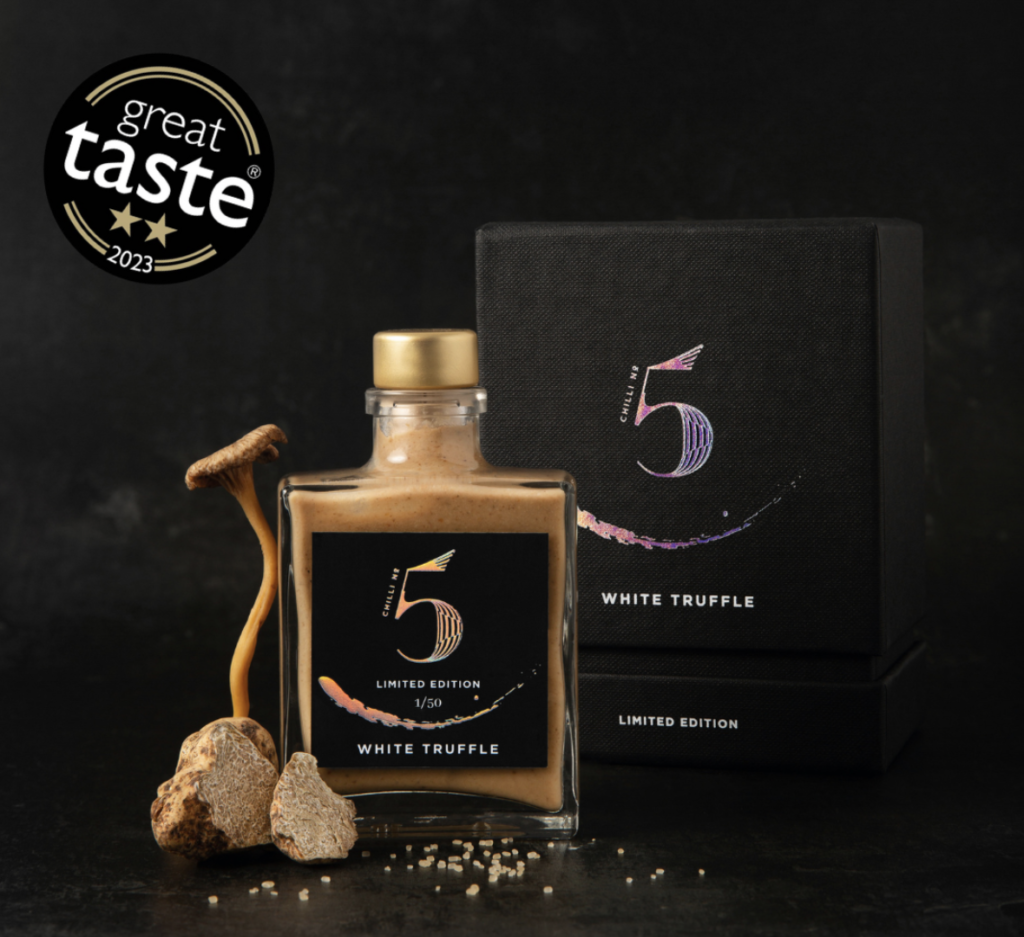
Every October, Chilli No. 5 founder Rumble Romagnoli visits Alba in Northern Italy to hunt and handpick white and black truffles that are used to make a yearly batch of the Chilli No. 5 White Truffle Hot sauce.
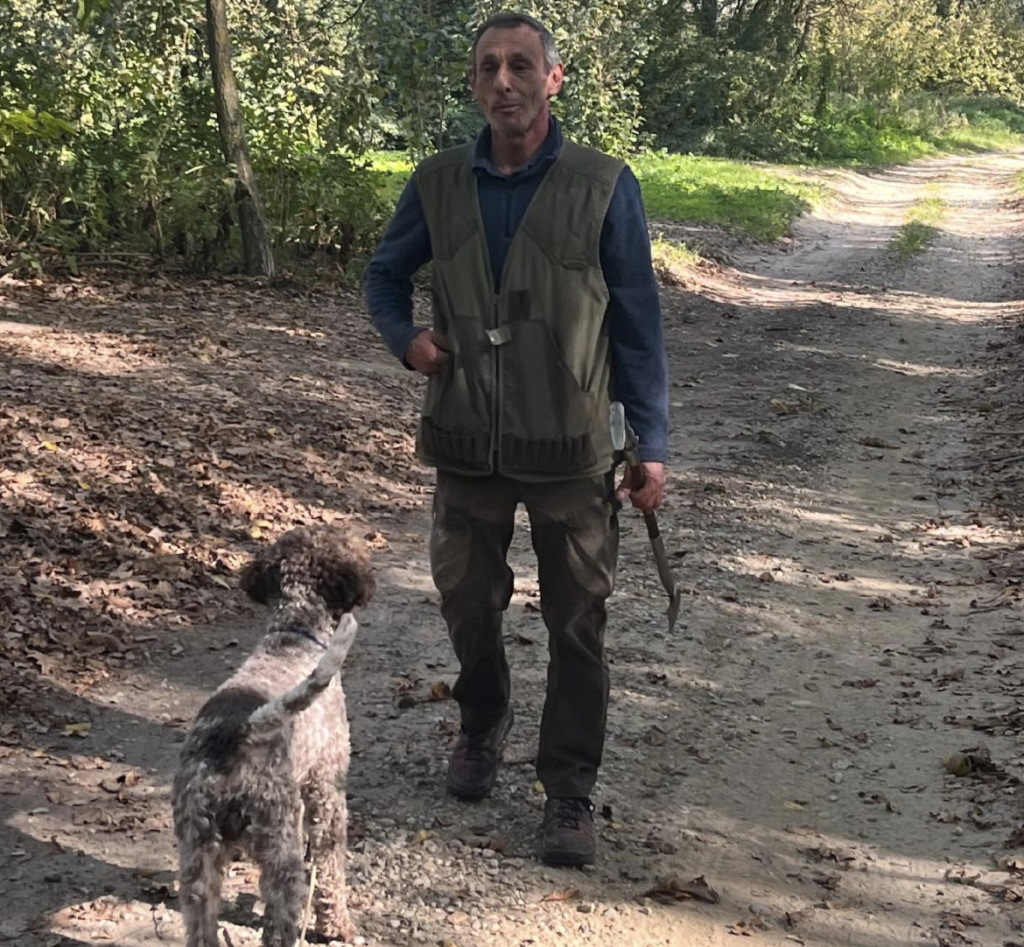
Truffle Hunter – Renzo, and Lagotto Romagnolo truffle dog – Charlie
The team has a dedicated Truffle Hunter – Renzo, and Lagotto Romagnolo truffle dog – Charlie to find the best truffles in the world. They also benefit from access to the truffle forest that has belonged to Renzo’s family for generations.
“Truffles are like diamonds. They cannot be made.
You have to find them.
Rumble Romagnoli
founder
“…Each one is unique. Close your eyes and bring the forest to life with this uber-umami white truffle sauce unmatched so far in the industry.” – Rumble Romagnoli founder says.
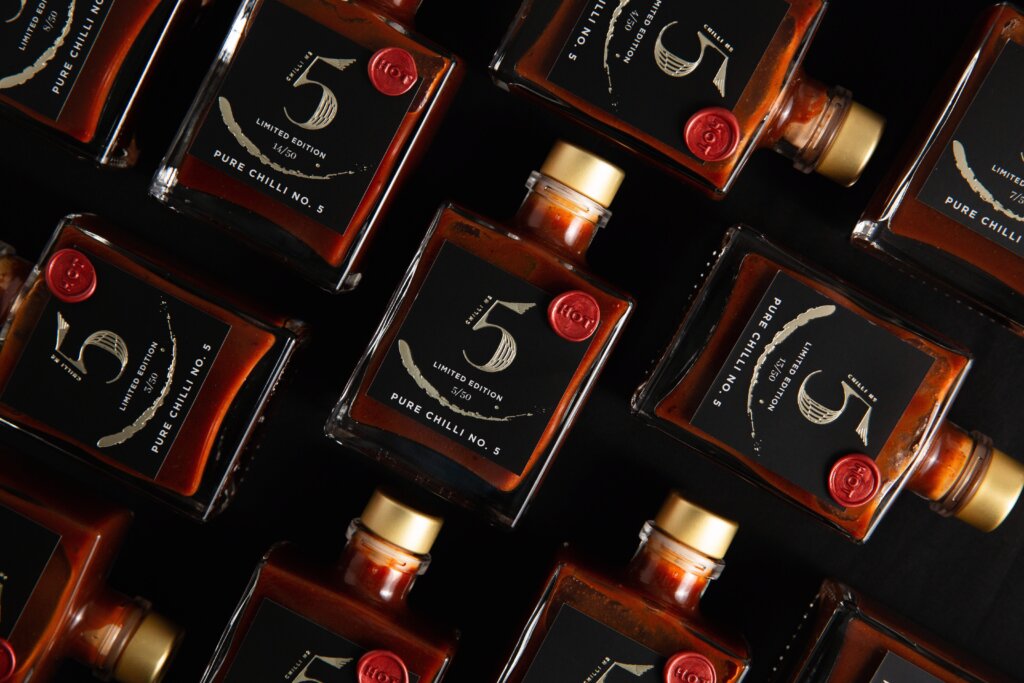
Romagnoli adds “You can understand that no expense was spared in sourcing the finest white truffles, carefully handpicked to ensure their unparalleled quality and aroma. Blended with a mix of fresh mushrooms such as Porcini, Ceps, Chantrelles, Girolles, and Morilles, this creation is a true culinary gem.”
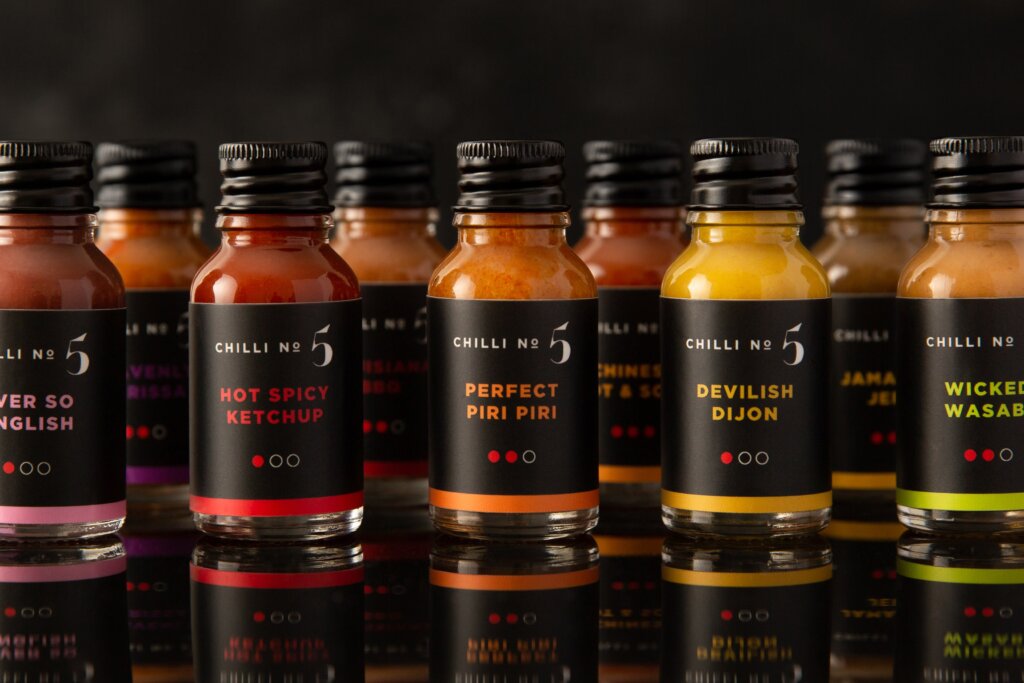
According to the Great Taste Award Judges “It becomes clear very quickly that this sauce has been made with real skill. The truffle is very much present but tamed at all times. The additional mushrooms combine for a really characterful sauce that offers umami in spades but has some acidity, tang and sweetness too. On top of all this artistry, there’s the late and subtle arrival of chilli heat to round it all off. This is a very complex sauce, but very accessible too.”
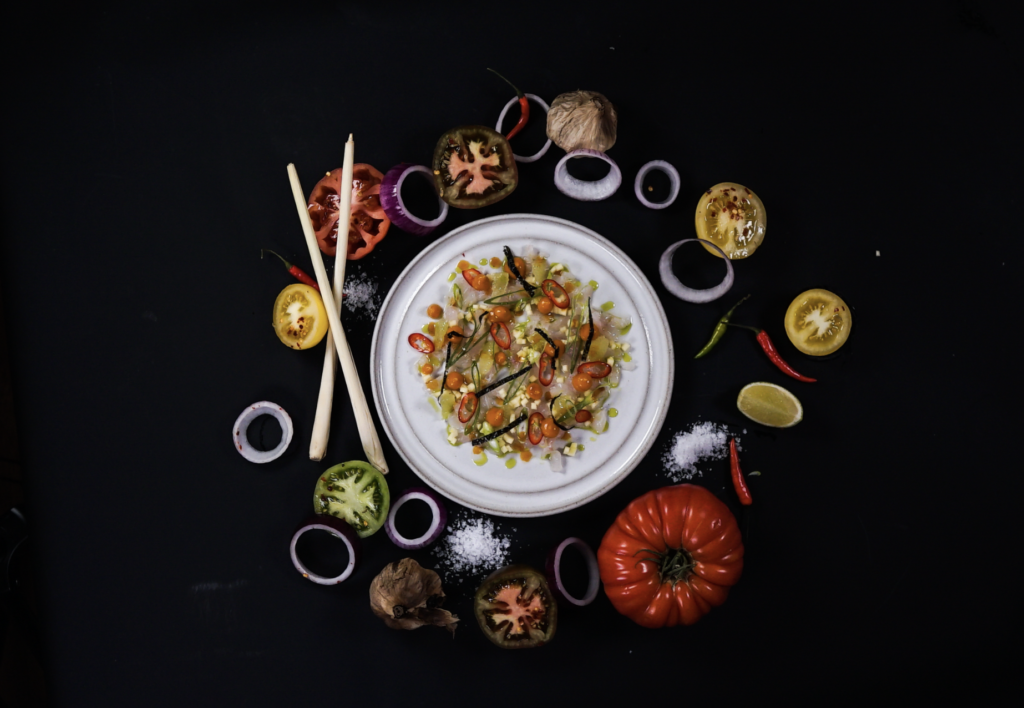
This unique White Truffle Hot Sauce will be a versatile addition to kitchens, grills, and BBQs all over the world used not only as a condiment, but also as marinade, and a BBQ sauce. Traditionally, truffle is used on plain pasta, risotto, or grilled meats to enhance the complexity of this unique flavour. The intoxicating aroma and robust, earthy flavour of white truffles create a truly sensory experience that will transport you to a world of culinary luxury.
Chilli No. 5’s White Truffle Sauce is a limited-edition offering, available for a limited time as only 50 bottles are produced each season. This new batch left the Chilli No. 5 kitchens today, so don’t miss the opportunity to add this rare delight to your upcoming culinary repertoire.
Chilli No. 5’s White Truffle Sauce is the perfect choice for discerning home cooks, food enthusiasts, and those seeking to impress guests with a touch of decadence. Whether you’re celebrating a special occasion, hosting an intimate dinner party, or simply indulging in a gourmet home-cooked meal, this sauce will leave a lasting impression.
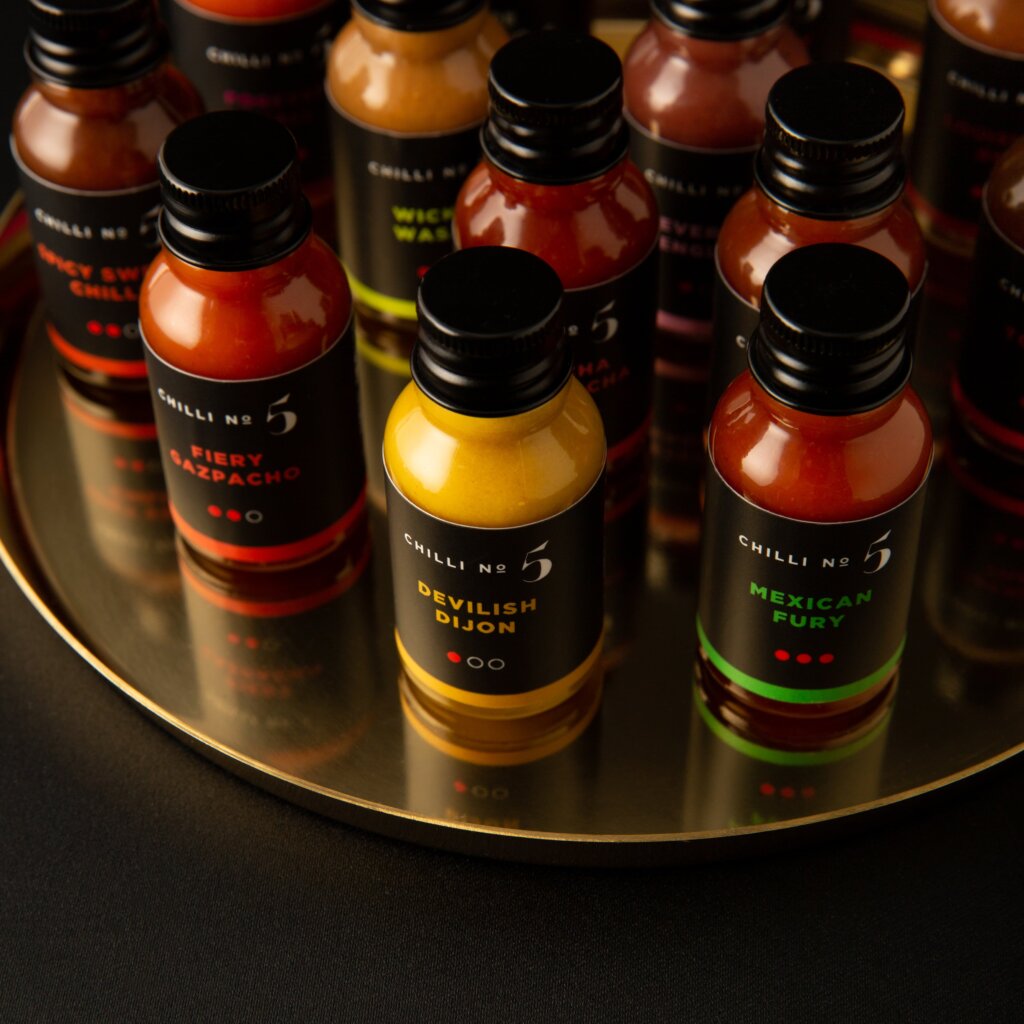
This limited-edition White Truffle Hot sauce goes with everything and is perfect for a chilli sauce gift in its designer sustainable packaging.
To explore the rich flavors of Chilli No. 5’s White Truffle Sauce and elevate your culinary creations, visit Chilli No. 5’s Website.
Post Views: 349 -
Sofitel Saigon Plaza Celebrates Its 25th Anniversary, commemorating a quarter century of Joie de Vivre in Vietnam
Sofitel Saigon Plaza Celebrates Its 25th Anniversary, commemorating a quarter century of Joie de Vivre in Vietnam.
Sofitel Saigon Plaza is delighted to commemorate a significant milestone this October with the celebration of its 25th anniversary.
Drawing inspiration from local Vietnamese culture and traditions while embracing life with a French zest is what the hotel successfully stands for a quarter century.

Daniël Stork, Consul General of The Netherlands, Mario Mendis, Sofitel Saigon Plaza GM and guests
Since its establishment in 1998, Sofitel Saigon Plaza has consistently delivered a 5-star luxury experience marked by heartfelt service and hospitality excellence in the heart of Ho Chi Minh.
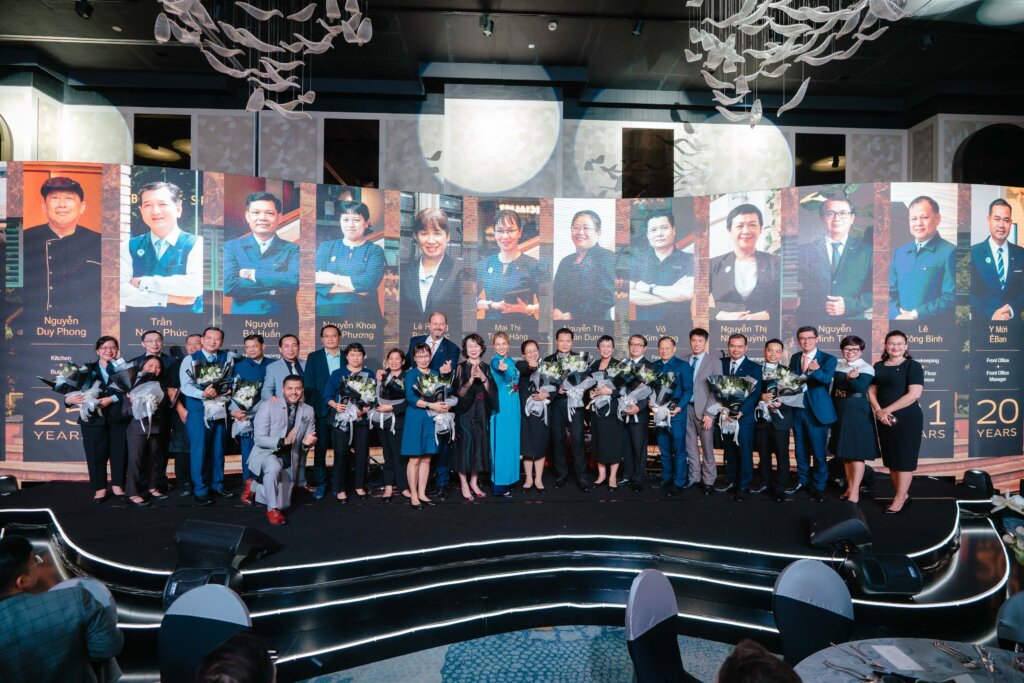
Globally acclaimed through the decades, Sofitel Saigon Plaza has welcomed dignitaries and political figures, from the former French President Francois Hollande to the US Secretary of State John Kerry.

Ambassador Lesly Benoit of Haiti performing with Jazztown
On October 5th 2023, Sofitel Saigon Plaza hosted an enchanting Anniversary Dinner at its opulent Diamond Hall in presence of Mrs Maud Bailly, CEO of Sofitel.

Maud Bailly, CEO of the Sofitel, M Gallery & Emblems Worldwide
At this extraordinary soirée, the hotel had the privilege of hosting esteemed guests, ranging from international diplomats and government officials to renowned celebrities, CEOs of prominent corporations, and dedicated Heartists (Accor team members) who have passionately served Sofitel Saigon Plaza for over two decades.
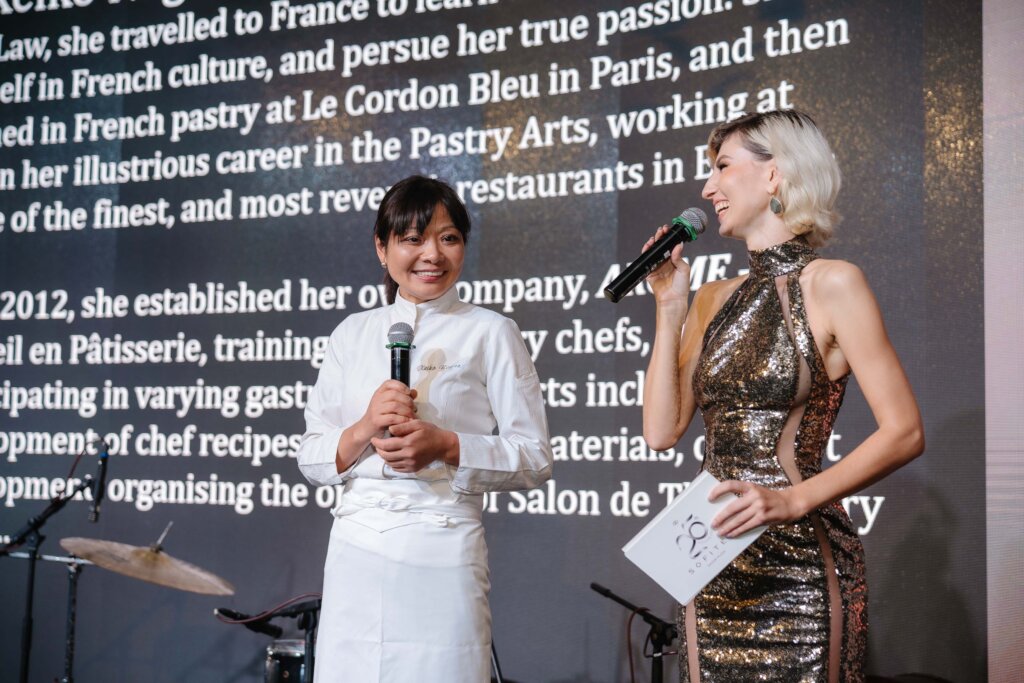
Chef Kieko Nagae
The honoured guests were thus invited to enjoy a sumptuous six-course dinner crafted by Michelin-star and celebrity chefs from Asia and France. This exquisite evening was topped off with spectacular performances blending these two cultures. To mark the occasion, Heartists whom are within the property since the opening have been highlighted and recognized for their exceptional commitment and remarkable work.
“Founded almost 60 years ago, Sofitel was the first French luxury hotel brand to develop an international network of hotels and resorts…
Maud Bailly
CEO of Sofitel
“…Each of the establishments now artfully blends the French art-de-vivre with the essence of the local destination, offering chic design, the best of culinary arts, and exceptional personalized service. The 25th anniversary was truly an illustration of the cultural link between France and Vietnam, exemplifying the symbolism of the Sofitel logo, which signifies the seamless blending of French and local cultures. Over these two and a half decades, we have not only celebrated the excellence of Sofitel but also the enchanting partnership of Saigon’s vibrant spirit with the elegance of French heritage. At Sofitel, we want to inspire people to celebrate life and its beauties with joy, impertinence, and, most of all, pleasure! This celebration embodies the essence of our vision, where the rich traditions of Saigon meet the sophistication of French savoir-faire, creating a world of endless delight and unforgettable moments”, commented Maud Bailly, CEO of Sofitel.

“It is a privilege to be part of an establishment that has redefined luxury, elegance, and service in Ho Chi Minh City. Our gratitude goes to our valued guests, passionate team, and partners who have been unwavering supports in this journey. This anniversary not only pay tribute to our past but also reaffirms our dedication to offer unforgettable experiences to our guests in the future”, said Mr. Mario Mendis, General Manager of Sofitel Saigon Plaza.

Michelle Wee- CEO Standard Chartered Vietnam – Madame Trang Le R- Counsel General Daniël Stork of The Netherlands
The festivities will continue during the 5th Saigon Gourmet Week, taking place from October 6th to 8th at Sofitel Saigon Plaza.

Event Curator and Producer Tracie May-Wagner
This event promises a delightful array of culinary experiences, including immersive cooking classes, exclusive lunches and dinners, and an unforgettable brunch featuring renowned chefs.

Phoung Nam Art Theater
The lineup includes Sébastien Voelker (French Pastry Chef), Truc Dinh (Vietnamese Chef), Shozo Tsuruhara (Japanese Chef), Victor Savall (Spanish Pastry Chef), Sakal Phoeung (French-Cambodian Chef), Keiko Nagae (French-Japanese Pastry Chef), Vuong Vo (Vietnamese Chef), Adrien Guenzi (French Chef), and French Michelin-Star Chef Thierry Renou.
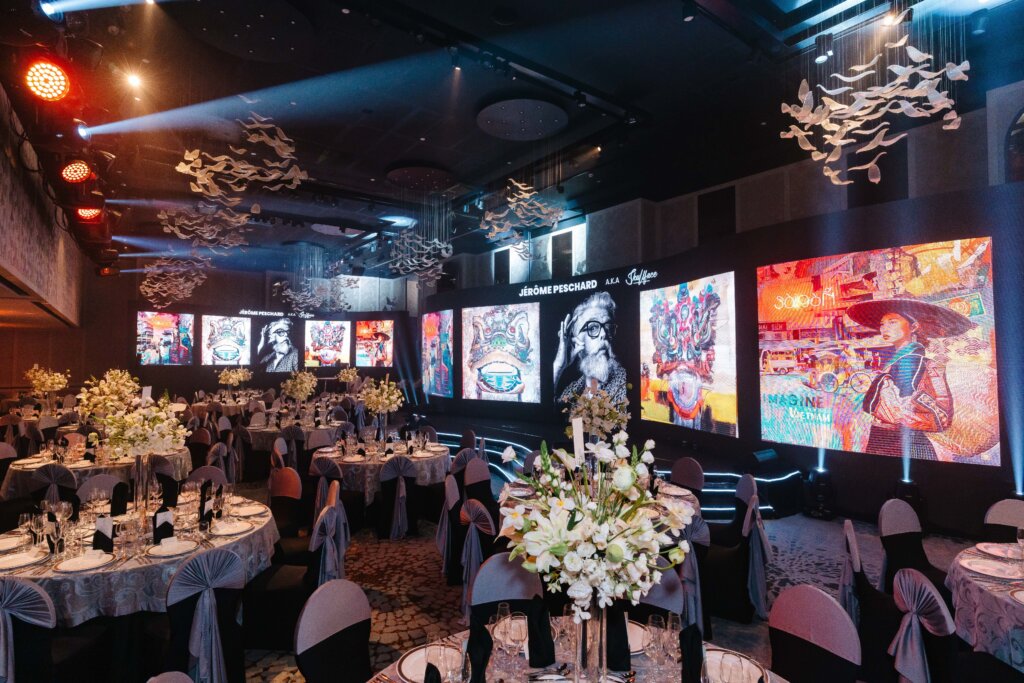
Sofitel Saigon Plaza
Sofitel Saigon Plaza harmonizes the sophistication of French art de vivre with the vibrancy of local Vietnamese culture, delivering a luxury hospitality experience enriched by genuine heartfelt service. Conveniently located in a tranquil enclave on Le Duan Boulevard, Sofitel Saigon Plaza places you in the heart of Ho Chi Minh City’s business, cultural, and shopping district.
The hotel boasts 286 rooms and suites adorned with refined décor and deluxe amenities, a fitness center feauring advanced exercise equipment, and an outdoor swimming pool with breathtaking city views.
Sofitel Saigon Plaza also features five dining establishments serving local and French cuisine, seven polished meeting rooms, and an opulent ballroom equipped with state-of-the-art facilities, making it the ideal destination for business, leisure, meetings, and gatherings.
Sofitel Hotels & Resorts
Sofitel Hotels & Resorts is an ambassador of modern French style, culture and art-de-vivre around the world.
Established in 1964, Sofitel is the first international luxury hotel brand to originate from France, with more than 120 chic and remarkable hotels in many of the world’s most sought-after destinations. Sofitel exudes a refined and understated sense of modern luxury, always blending a touch of French elegance with the very best of the locale.
Sofitel also includes a selection of heritage luxury hotels under the Sofitel Legend banner, renowned for their timeless elegance and storied past.
Some notable hotels in the Sofitel portfolio include Sofitel Paris Le Scribe Opera, Sofitel London St James, Sofitel Dubai The Obelisk, Sofitel Legend Old Cataract Aswan, Sofitel Mexico City Reforma, Sofitel Legend Santa Clara Cartagena, Sofitel Legend Metropole Hanoi and Sofitel Ambassador Seoul.
Sofitel is part of Accor, a world leading hospitality group counting over 5,400 properties throughout more than 110 countries, and a participating brand in ALL – Accor Live Limitless – a lifestyle loyalty program providing access to a wide variety of rewards, services and experiences.
sofitel.accor.com | all.accor.com | group.accor.com
Post Views: 1,292 -
DC Discovers Aphrodise Sparkling Wine, Taste it Before Your next Party, Frank Schilling Reveals
DC Discovers Aphrodise Sparkling Wine, Taste it Before Your next Party, Frank Schilling Reveals
Whether it’s a wedding, party, or just drinks with dinner. We want taste. Maybe we want a few drinks. We also want to protect ourselves from tomorrow’s hangover.
It’s hard to find a drink that can take day to night quite like a Greek rosé and Aphrodise wants to prove it to you.

Frank Schilling, Co-Founder of Aphrodise
Today’s conversation with Frank Schilling from Aphrodise has been edited for length and clarity. For the full, un-edited conversation, visit our YouTube channel here.
Joe Winger:
Our audience is foodies. We’re wine lovers. What’s the most important message today you want to share with an audience of foodies and wine lovers?
Frank Schilling:
I’m an Epicurean myself. I don’t have a lot of pretense around my love of food and wine, I just love great food and wine and I’ve tasted so many great things.
I’m a character who hasn’t had a meal at home in 22 years. As an internet entrepreneur, I used to work, literally seven days a week for many years and eating out was my escape from my work because it’s the one place my laptop and phone couldn’t rule the day, or the moment.
For me, eating out was that escape and that vacation of the moment.
I created a life around dining out probably like many of your listeners or viewers. And I have a deep well of respect for great food and wine and also for the people who admire it and chase it, it’s a, it’s one of the great things in life.
I’m always stunned by people who don’t truly love food. I feel like they’re missing something and leaving part of life on the table.
Discovering Aphrodise sparkling wine
Joe Winger:
You have this new discovery. Let’s talk a little bit about Aphrodise. Tell me about how you discovered the grape varietal?
Frank Schilling:
I’m a wine lover. I tasted my way through Bordeaux and Burgundy.
All the way through, I could never really tell a Merlot from a Cab. I’d be lying to you if I said I knew what a Nebbiolo or a Valpolicella was and how all those grapes differed from each other.
I do enjoy great brands of wine. I do understand the difference between years and what impacts a year.
But when I was building [my restaurant] it was COVID. I was doing some fingertip math and I realized we’re gonna have to start bringing over a lot of sparkling [wine] for mimosas and for brunch. It was 300 seat restaurant, two seatings, 600 seats on a brunch [shift].
You start to do the math and you realize, “Wow, 52 weekends a year, bottomless mimosas. I’m going to need about 3,000 bottles of wine per quarter of champagne. So let’s go out and get some. We live on an island and supply chain management wasn’t really an option.
So we started to taste through different varieties of champagne.
I came to discover what Tom Cruise did in [the movie] “Cocktail”, which is, champagne is like perfume going down, but like sewage on the way back.
It comes from a well meant place, not mean spirited towards the great region of Champagne.

Joining the Aphrodise sparkling wine party
It’s just the nature of Champenois produced wine and that Chardonnay grape that makes a beautiful champagne is such that you just can’t consume a lot of it in the heat or humidity in the sun.
Traditional Champagne vs Aphrodise Sparkling Wine
It just isn’t the type of forgiving libation that lets you function afterwards and you don’t feel good.
The yeast isn’t good for a lot of people. Not everybody’s impacted the same way but, a large portion of the population doesn’t do well with champagne and heat in sunlight as a day drink.
The recovery profile isn’t something that people look forward to.

Aphrodise from the grape varietal called Xenomavro
I discovered that I’d had that problem myself for years. The yeast wasn’t working for me.
So when I discovered Aphrodise, it was a grape varietal called Xenomavro.
A high altitude grape, Greece’s most noble grape.
It’s a very forgiving drink. In a sparkling format, it’s something you can drink in the heat, it’s something you can drink in larger quantities, I can tell you that the recovery profile, for me and for many others, is exceptionally good.
Meaning you can drink a lot of it and bounce back and go again.
As a wine producer, that’s music to your ears. But it’s also nice knowing I’m making people feel better. I’m not putting something in the market that’s going to make you feel sick after overconsumption.

At a party enjoying Aphrodise Sparkling Wine
Joe Winger:
Just to give a little backstory. Frank, I hope you’ll talk to us a little bit about one of your first adventures. You mentioned you’re an internet entrepreneur, you had some success with website domains.
Can you explain a little bit about that and maybe a lesson you learned from that journey?
Frank Schilling:
It’s a lesson that some of your listeners and viewers probably have some experience with.
I registered a domain name back in the dot com era. Then I registered 2 [dot com names], then 10 and I got some generic names like wine.com , cars.com. Names like those.
I started to realize, wow, these names have value.
I wound up registering a lot of generic names and then I had difficulty managing them because in those early days of the Internet, it was all very unwieldy. The infrastructure for managing those names.
So I created a lot of that management infrastructure. Then in the process, grew that business over a 20 year horizon and wound up selling the 3 companies that comprised that enterprise to a company called GoDaddy, which we’ve probably all heard of.
So some of their infrastructure was my infrastructure and is now their infrastructure.
To the extent you like the new GoDaddy offering for managing domain names, you’re welcome, for the small part I played in helping that become a reality.
In the old days, I was traveling a lot. I had an office in Manchester in the United Kingdom, one in Newport beach in California and my main office here in the Cayman Islands. I would travel between the offices, New York, Miami and many other cities, just for work all around the world.

Enjoying Aphrodise Sparkling Wine
At the beginning of COVID that all came to a grinding halt. I sold those businesses and decided that with my love of food, if I was going to stay in the Cayman Islands, I realized I’m gonna have to eat at home more and I realized, the offerings of restaurants wasn’t the depth was hoping for.
So I built the restaurant, as a result of that that then led to Aphrodise.
Joe Winger:
I love the full circle of it.
Since we’ve mentioned the restaurant once or twice. Can we hear more about your restaurant Mykonos Cayman?
Frank Schilling:
Sure. During COVID lockdowns, there was a new plaza going in on the beach and I had mentally designed a restaurant years ago, but sold the real estate for it.
So when I saw the plaza going up, I was crestfallen. These guys built my dream on their land. My fantasy of what a place would look like. But then I was happy to learn that the plaza was a strata titled affair. It wasn’t owned by one conglomerate.
So I bought into that plaza so I could control the real estate. Then once I had the real estate I did a sort of “money no object” fit out that left a very residential-looking restaurant really quite beautiful.
I love the culture of Greece and I love the idea of the long lunch and the lack of pretense in the party and [being] all welcoming, with children, grownups will dance on the table and get really carried away.
The kids are running around. It’s all very loving and family oriented.
Whereas, Ibiza is a little more drug fueled and party, ragey and a little more intense.
I loved the soulful day party of Greece. We’re on an island and the Greeks are on islands. So I thought how nice it would be to bring some of that to my reserved island here in Grand Cayman. Grand Cayman is more of a place you quietly go to escape and enjoy the beach and family.
It’s not really a St. Bart’s where you go to seek out a great party. I always hoped that there’d be room for at least one place like they have in St. Bart’s here.
So I built a really big place, 320 seats, super residential, relaxed, welcoming, But completely devoid of pretense. You can come in, flip flops and shorts, or you can come in a beautiful gown as we’d hope in the evening.
But we don’t have a lot of structure and posture around it. We want you to feel free when you come. So that, I built that venue here, and you can see it online.
It’s called Mykonos Cayman. We have an Instagram where people can learn about the restaurant.
When you come, please come for a glass of Aphrodise on me. Mention Frank said I could have a glass of Aphrodise
Joe Winger:
You introduced Aphrodise at the Las Vegas Wedding Show. How did it go? Why do you think Aphrodise is the best drink to have at a wedding?
Frank Schilling:
It’s the color of love. It’s a beautiful color of red.
We took it to the wedding show because I thought that wedding planners would share the same pain point that I discovered as a restaurateur. Which is, if you want to buy a bottle of great champagne, easy, you go to the liquor store.
But when you start getting up there and you need 100 cases for an event or a series of events, getting that quantity consistently and getting a good product is actually quite difficult. And expensive.
So we thought we’d introduce Aphrodise.
Knowing that we could go directly to the wedding planners and help their fulfillment and execution and deliver a better product.
Something that people could really lavish in the heat or at an after party where you’re really enjoying the bubbly and then feel better in the morning. That was really the goal.
My first champagne experience was at a wedding and I drank a little too much. For the next day or two, I was laid up.
So we try to bring something to market that is good for people or at least makes them feel good in the moment and helps them recover.
We had a line all day. I poured a 5,000 servings of Aphrodise that day. People loved it.
Let me tell you, that’s a lot of work, opening bottles. It looks very glamorous. But when you’re really going at velocity, my hands hurt at the end of the day.
We got a lot of upstart business out of that. People were like, “Wow, this stuff is actually quite good.’
Joe Winger:
Let’s talk about flavor profile.
Pouring out 5,000 samples, what’s the most common feedback we get about the flavor, aroma, the mouthfeel, what are we experiencing?
Frank Schilling:
So when you sip a drink and you talk about mouthfeel or we have a glass of wine or champagne and you have a sip and there’s a little bit of a yeasty, gamey after taste.
For some people in red wine, it can be somewhat desirable.
In champagne, unfortunately it stays with it as well.
When you’re having champagne, which is more of a celebratory libation, that’s not a desirable quality. You want to have something that finishes clean in your mouth.
If you have lots of sips, you’re going to get a good buzz. You want to be able to recover quickly and elegantly without that headache that comes from the yeast and all those elements that bring its flavor.
So the taste of Aphrodise is a very clean mouthfeel and it finishes with a light crisp apple or cherry. Some people taste strawberry.
It’s a small bubble. Very light charmat, produced in small vats, a naturally produced bubbly effect. It lives in tanks for 3 months and it gains its bubbly in a natural way.
A little more expensive to produce that way. Prosecco, for example, will carbonate. They’ll add carbonation just like you would to a can of soda.
We don’t carbonate. We allow the bubbly to form naturally through the fermentation process, which is how it should be.

Co-Founders of Aphrodise Sparkling Wine
Joe Winger:
When it comes to food and wine pairing. What would be your favorite dish to pair with a glass of Aphrodise?
Frank Schilling:
Aphrodise is literally the only thing that I drink, and I’m crestfallen when I can’t find it.
It’s a dark rosé so it goes nicely with meat – a burger or a steak. Chicken or fish. It’s also a great dessert drink.
I like Aphrodise as a warmup libation and as an after dinner, like celebratory drink if you’re having a party, there’s an after party.
Joe Winger:
You’ve done a lot in your life. You’ve had a lot of adventures, a lot of successes.
Any inspiration or lessons you can share with the audience?
Frank Schilling:
The answer is love for people and love for living your best life, love for conviviality. I have a lot of love for the people that I encountered that have helped me in my journey. Those who’ve just been a part of my life, there for a season or there for a reason, as the saying goes, I try to embrace everybody.
See the good in everybody. There are people you click with more than other people. I say yes to everything unless it hurts me. I have a real lust for life and a good energy level.
Joe Winger:
If you’re loving Frank’s energy and his positivity, you wrote an amazing book. Would you mind giving us a summary of the book and what it was like writing it?
Frank Schilling:
It’s called Omnia Vincent: the universe wants you to win.
I wrote the book as I’d sold my businesses. It was during COVID lockdowns and everybody was [going through a] “The end of the world” mood type thing at that time.
You write a book like this for your grandchildren. If one day they want to know more about grandpa and did our success come from or where did our financial wealth come from?
It’s nice for them to know a little about the person who tried hard and maybe you can see something in yourself. So I really wrote it for my future ancestors.
I want to be the guy who left something for the grandkids and great grandkids to understand a little about my brain. And it’s really just written in short micro chapters.

Joe Winger:
Because you’re an epicurean, if you’re going to have any plate for dinner tonight, what would it be and why?
Frank Schilling:
Tonight I’m actually feeling a Pittsburgh style steak, seared on the outside. I haven’t had good red meat in about a week, and we just got some A5 Wagyu at the restaurant Our chef is a butcher and he’s also a certified Angus ambassador. So he gets great cuts.
We do a beautiful short rib burger, which is really lean short rib again on the outside with a bit of a char finish. We have a charcoal grill inside the restaurant, which is beautiful.
Joe Winger:
Thank you so much for your time. If someone wants to learn more, what are the best ways to find and follow websites, social media for Aphrodise?
Frank Schilling:
DrinkAphrodise on Instagram and the website DrinkAphrodise.com
Post Views: 108





